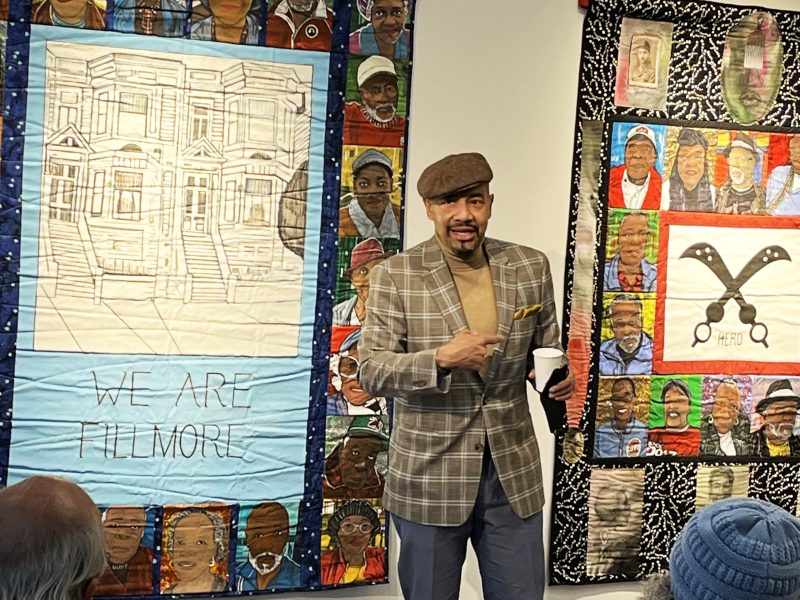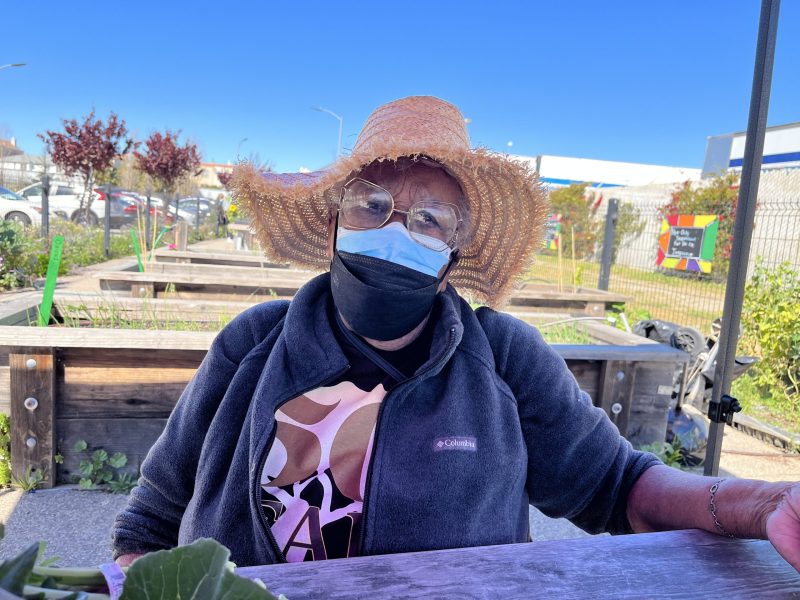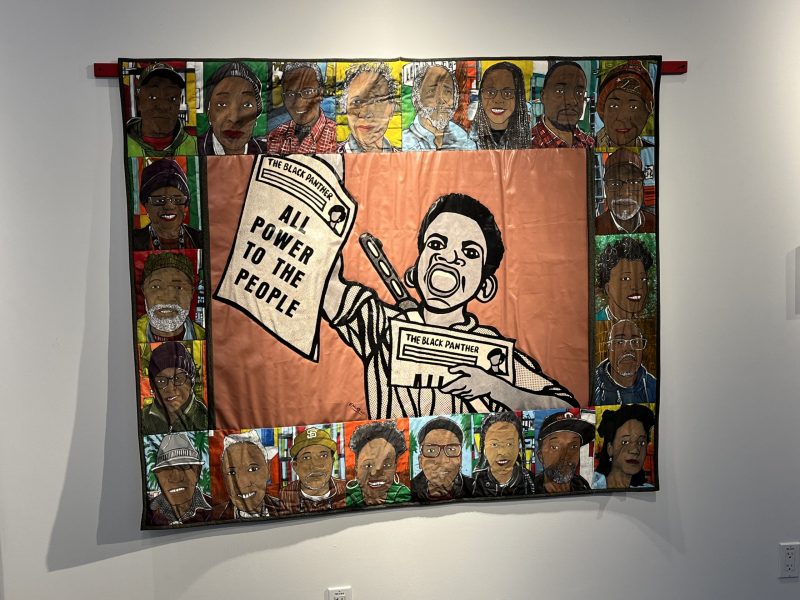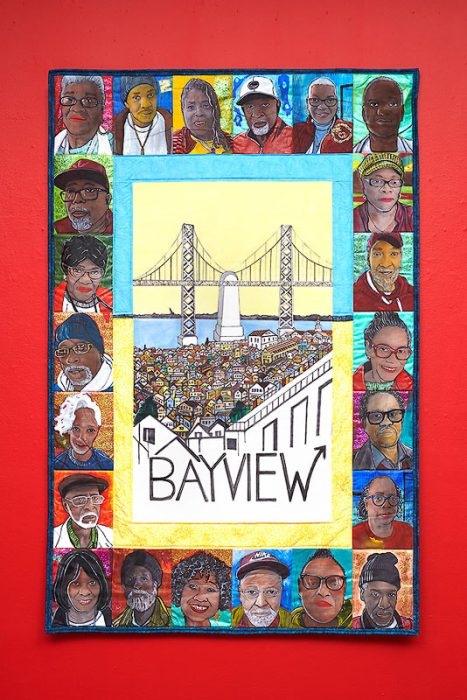Bayview seniors and youth work and learn together in award-winning program led by artist whose quilts feature city’s Black residents.
It’s a spring-like March morning in San Francisco’s Bayview neighborhood. A gaggle of preschoolers is busy painting wooden stakes to mark plantings in the garden of the Dr. George W. Davis Senior Center.
They’re working under the watchful eyes of teachers from a nearby elementary school as well as Bayview residents, mostly in their 70s and 80s, who live at the center or in the neighborhood. The garden’s raised planter boxes are lush with a variety of herbs, collard greens, lettuce and tomatoes.

The weekly gardening sessions are designed to introduce the children to healthy eating and basic nutritional concepts, said Miss Mohammed, who teaches at the Dr. Charles Drew Early Education School attended by the children. “If you teach them at this age, they’ll learn to cook and shop for nutritious foods.”
‘We learn from the children’
But the sessions have a purpose that goes well beyond gardening: They’re designed to put young people in touch with neighborhood seniors. “As older people, we learn so much from the children,” said Gerri Hill, 82, a retired early education teacher who lives at the Davis Center.
The gardening program is just one of a series of “intergenerational programs” sponsored by Bayview Senior Services, supervised and largely conceived by 55-year-old William Rhodes, a Baltimore-born artist.

“It is about connecting the generations because we know seniors suffer from social isolation and feeling unimportant to the community,” he said in a recent interview. “There are so many young people in the Bayview with no grandparents and who don’t know how to interact with older people.”
According to its blog, Bayview Senior Services has a history of informal intergenerational participation in its programming and had long wanted to create more structured activities that bring people of different generations together. But the service needed someone to develop a defined program and lead it.
Rhodes, who moved to San Francisco in 2008, became program director in 2019. He was known for his work in the city’s Black community and South Africa, and for his series of quilts on themes related to Black people in the Fillmore and Bayview neighborhoods.

Jackie Williams, 76, was tending a planting of lettuce and collard greens. She works with teens in the garden, who come separately from the preschoolers. Developing mutual respect is important, she said, She calls them young men, not boys, and expects courtesy and politeness in return.
A glance at the Intergenerational Blog of Bayview Senior Services highlights the variety of programs. Along with gardening, there are classes in painting, glass making and drumming. Participants in the Intergenerational Dance Exchange were initially videotaped sharing their best dance moves and later participated in a series of months-long virtual classes. Seniors and high school students take walks together, talking about their lives.
Inspired by the young
The pandemic forced most of the programs to go virtual and suspended others, but with the lessening of the health emergency, they are slowly being restored.
The California Institute of Integral Studies is about five miles from the Davis Center. Two days after the preschoolers worked in the garden, a vanload of seniors from the center arrived at the college.
They were there for the opening of an exhibit featuring paintings they created in the center’s intergenerational program – and to view a series of African American-themed quilts made by Rhodes.
A long hallway in the center was lined with their work, and Rhodes encouraged the artists to speak about their paintings and what inspired them.

For Gerri Boonehill, 82, it was the words and work of Barrack Obama. The portrait of the former president, which she calls “A Legacy of Hope,” is a bit abstract; his face is depicted in various hues and his ears are exaggerated. “His ears represented what I was hearing,” she said. “I see all the different colors that include everyone.”

Creative young people, said Wesley Frazier, 71, helped him start painting about two years ago. Standing in front of his still life of a bowl of fruit, he said, “I just want to create for as long as I can.”
Linda Powell’s painting of three generations of women comes from her own family’s story. The portrait, the 75-year-old Davis Center resident said, “will be a legacy I pass on to my grandchildren.” She calls the work “My Ladies.”
One of the Rhodes quilts on display was inspired by Emory Douglas, the artist who created the highly political, poster-like art on the back page of the Black Panther Party’s newspaper. It replicates his drawing of a Black woman, assault rifle slung from a shoulder holding a copy of the paper with the headline “All Power to the People,” the Panther’s slogan.

Around the border of the quilts are the portraits of community members. “I’m not much of a portrait artist,” said Rhodes. “So I start with a photo.” He then projects the photo onto the fabric and paints it with acrylics. The squares are stitched together with help from women in the community.
If Rhodes were a bit taller and stockier, he probably wouldn’t have become the artist he is today, he said. “I was a small guy with no siblings to protect me. I got jumped a lot; even had my nose broken.”

He liked to draw and art became a sort of therapy. “It was my release,” Rhodes said. His aptitude for art won admission to the Baltimore School of the Arts. “I knew if I didn’t keep up my grades I’d be out and back in a rough neighborhood school.”
He later attended the University of the Arts in Philadelphia and graduate school at the University of Massachusetts where he majored in furniture making and design. His portfolio includes art in multiple mediums, including quilting, painting, gold leaf, and sculptures that incorporate neon.
Feeling valued
Quilting, though, is personal for Rhodes. He was inspired by close family friends who excelled in the art, and it became a favored method of expression. He spent time in South Africa, where he taught art and was instrumental in the formation of the Nelson Mandela quilt project, which combined the work of youngsters from Cape Town, South Africa, and Bayview.
The paintings will remain on display at the California Institute of Integral Studies, 1453 Mission St., through the end of April; the quilts will be there until April 8.
Rhodes’ contention that intergenerational programs help seniors feel connected to the community was borne out last year when The National Association of Area Agencies on Aging named Bayview’s intergenerational programs a winner of its Aging Achievement Award.
According to the award statement, 97 percent of the seniors who participated and were surveyed said the program helped them develop new relationships and reinforced feelings of being valued community members.






Loring Cornish
Very cool article